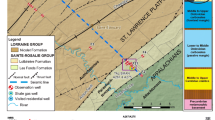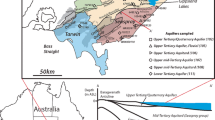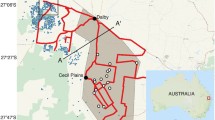Abstract
Degradation of groundwater quality is a primary public concern in rural hydraulic fracturing areas. Previous studies have shown that natural gas methane (CH4) is present in groundwater near shale gas wells in the Marcellus Shale of Pennsylvania, but did not have pre-drilling baseline measurements. Here, we present the results of a free public water testing program in the Utica Shale of Ohio, where we measured CH4 concentration, CH4 stable isotopic composition, and pH and conductivity along temporal and spatial gradients of hydraulic fracturing activity. Dissolved CH4 ranged from 0.2 μg/L to 25 mg/L, and stable isotopic measurements indicated a predominantly biogenic carbonate reduction CH4 source. Radiocarbon dating of CH4 in combination with stable isotopic analysis of CH4 in three samples indicated that fossil C substrates are the source of CH4 in groundwater, with one 14C date indicative of modern biogenic carbonate reduction. We found no relationship between CH4 concentration or source in groundwater and proximity to active gas well sites. No significant changes in CH4 concentration, CH4 isotopic composition, pH, or conductivity in water wells were observed during the study period. These data indicate that high levels of biogenic CH4 can be present in groundwater wells independent of hydraulic fracturing activity and affirm the need for isotopic or other fingerprinting techniques for CH4 source identification. Continued monitoring of private drinking water wells is critical to ensure that groundwater quality is not altered as hydraulic fracturing activity continues in the region.

A shale gas well in rural Appalachian Ohio. Photo credit: Claire Botner.







Similar content being viewed by others
References
Akob, D. M., Cozzarelli, I. M., Dunlap, D. S., Rowan, E. L., & Lorah, M. M. (2015). Organic and inorganic composition and microbiology of produced waters from Pennsylvania shale gas wells. Applied Geochemistry, 60, 116–125. https://doi.org/10.1016/j.apgeochem.2015.04.011.
Akob, D. M., Mumford, A. C., Orem, W., Engle, M. A., Klinges, J. G., Kent, D. B., & Cozzarelli, I. M. (2016). Wastewater disposal from unconventional oil and gas development degrades stream quality at a West Virginia injection facility. Environmental Science & Technology, 50, 5517–5525. https://doi.org/10.1021/acs.est.6b00428.
Aravena, R., Wassenaar, L. I., & Plummer, L. N. (1995). Estimating 14C groundwater ages in a methanogenic aquifer. Water Resources Research, 31, 2307–2317. https://doi.org/10.1029/95WR01271.
Beaulieu, J. J., Smolenski, R. L., Nietch, C. T., Townsend-Small, A., & Elovitz, M. S. (2014). High methane emissions from a midlatitude reservoir draining an agricultural watershed. Environmental Science & Technology, 48, 11100–11108. https://doi.org/10.1021/es501871g.
Brantley, S. L., Yoxtheimer, D., Arjmand, S., Grieve, P., Vidic, R., Pollak, J., Llewellyn, G. T., Abad, J., & Simon, C. (2014). Water resource impacts during unconventional shale gas development: the Pennsylvania experience. International Journal of Coal Geology, 126, 140–156. https://doi.org/10.1016/j.coal.2013.12.017.
Caulton, D. R., Shepson, P. B., Santoro, R. L., Sparks, J. P., Howarth, R. W., Ingraffea, A. R., Cambaliza, M. O. L., Sweeney, C., Karion, A., Davis, K. J., Stirm, B. H., Montzka, S. A., & Miller, B. R. (2014). Toward a better understanding and quantification of methane emissions from shale gas development. Proceedings of the National Academy of Sciences USA, 111, 6237–6242. https://doi.org/10.1073/pnas.1316546111.
Clayton, J. L. (1998). Geochemistry of coalbed gas—a review. International Journal of Coal Geology, 35, 159–173. https://doi.org/10.1016/S0166-5162(97)00017-7.
Darrah, T. H., Vengosh, A., Jackson, R. B., Warner, N., & Poreda, R. J. (2014). Noble gases identify the mechanisms of fugitive gas contamination in drinking-water wells overlying the Marcellus and Barnett shales. Proceedings of the National Academy of Sciences USA, 111(39), 14076–14081. https://doi.org/10.1073/pnas.1322107111.
Darrah, T. H., Jackson, R. B., Vengosh, A., Warner, N. R., Whyte, C. J., Walsh, T. B., Kondash, A. J., & Poreda, R. J. (2015). The evolution of Devonian hydrocarbon gases in shallow aquifers of the northern Appalachian Basin: insights from integrating noble gas and hydrocarbon geochemistry. Geochimica et Cosmochimica Acta, 17, 321–355. https://doi.org/10.1016/j.gca.2015.09.006.
DiGuilio, D. C., & Jackson, R. B. (2016). Impact to underground sources of drinking water and domestic wells from production well stimulation and completion practices in the Pavilion, Wyoming, field. Environmental Science & Technology, 50, 4524–4536. https://doi.org/10.1021/acs.est.5b04970.
Drollette, B. D., Hoelzer, K., Warner, N. R., Darrah, T. H., Karatum, O., O’Connor, M. P., Nelson, R. K., Fernandez, L. A., Reddy, C. M., Vengosh, A., Jackson, R. B., Elsner, M., & Plata, D. L. (2015). Elevated levels of diesel range organic compounds in groundwater near Marcellus gas operations are derived from surface activities, Proceedings of the National Academy of Sciences USA., 112, 13184–13189. https://doi.org/10.1073/pnas.11511474112.
Garnett, M. H., Hardie, S. M. L., Murray, C., & Billett, M. F. (2013). Radiocarbon dating of methane and carbon dioxide evaded from a temperate peatland stream. Biogeochemistry, 14, 213–223. https://doi.org/10.1007/s10533-012-9804-2.
Griffith, M. B. (2014). Natural variation and current reference for specific conductivity and major ions in wadeable streams of the conterminous USA. BioOne, 33, 1–17. https://doi.org/10.1086/674704.
Harkness, J. S., Darrah, T. H., Warner, T. H., Whyte, C. J., Moore, M. T., Millot, R., Kloppmann, W., Jackson, R. B., & Vengosh, A. (2017). The geochemistry of naturally occurring methane and saline groundwater in an area of unconventional shale gas development. Geochimica et Cosmochimica Acta, 208, 302–334. https://doi.org/10.1016/j.gca.2017.03.039.
Hildebrand, Z. L., Carlton, D. D., Fontenot, B. E., Melk, J. M., Walton, J. L., Taylor, J. T., Thacker, J. B., Korlie, S., Shelor, C. P., Henderson, D., et al. (2015). A comprehensive analysis of groundwater quality in the Barnett shale region. Environmental Science & Technology, 49, 8254–8262. https://doi.org/10.1021/acs.est.5b01526.
Howarth, R. W., Santoro, R., & Ingraffea, A. (2011). Methane and the greenhouse-gas footprint of natural gas from shale formations. Climatic Change, 106(4), 679–690. https://doi.org/10.1007/s10584-011-0061-5.
Humez, P., Mayer, B., Ing, J., Nightingale, M., Becker, V., Kingston, A., Akbilgik, O., & Taylor, S. (2016a). Occurrence and origin of methane in groundwater in Alberta (Canada): gas geochemical and isotopic approaches. Science of the Total Environment, 541, 1253–1268. https://doi.org/10.1016/j.scitotenv.2015.09.055.
Humez, P., Mayer, B., Nightingale, M., Ing, J., Becker, V., Jones, D., & Lam, V. (2016b). An 8-year record of gas geochemistry and isotopic composition of methane during baseline sampling at a groundwater observation well in Alberta (Canada). Hydrogeology Journal, 24, 109–122. https://doi.org/10.1007/s10040-015-1319-1.
Ioffe, B. V., & Vitenburg, A. G. (1984). Head-space analysis and related methods in gas chromatography. New York: Wiley.
Jackson, R. B., Vengosh, A., Darrah, T. H., Warner, N. R., Down, A., Poreda, R. J., Osborn, S. G., Zhao, K., & Karr, J. D. (2013). Increased stray gas abundance in a subset of drinking water wells near Marcellus shale gas extraction. Proceedings of the National Academy of Sciences USA, 110, 11250–11255. https://doi.org/10.1073/pnas.1221635110.
Jenden, P. D., Drazan, D. J., & Kaplan, I. R. (1993). Mixing of thermogenic natural gases in northern Appalachian basin. AAPG Bulletin, 77, 980–998 http://aapgbull.geoscienceworld.org/content/77/6/980.
Kerr, R. A. (2010). Natural gas from shale bursts onto the scene. Science, 328(5986), 1624–1626. https://doi.org/10.1126/science.328.5986.1624.
Kozlowska, M., Brudzinski, M. R., Friberg, P., Skoumal, R. J., Baxter, N. D., & Currie, B. S. (2018). Maturity of nearby faults influences seismic hazard from hydraulic fracturing. Proceedings of the National Academy of Sciences USA, 115, E1720–E1729. https://doi.org/10.1073/pnas.1715284115.
Laughrey, C. D., & Baldassare, F. J. (1998). Geochemistry and origin of some natural gases in the plateau province, central Appalachian basin, Pennsylvania and Ohio. AAPG Bulletin, 82, 317–335 http://aapgbull.geoscienceworld.org/content/82/2/317.
Levin, I., & Hesshaimer, V. (2000). Radiocarbon—a unique tracer of global carbon cycle dynamics. Radiocarbon, 42, 69–80 https://journals.uair.arizona.edu/index.php/radiocarbon/article/viewFile/3855/3280.
Liu, T. K., Chen, K. Y., Yang, T. F., Chen, Y. G., Chen, W. F., Kang, S. C., & Lee, C. P. (2009). Origin of methane in high-arsenic groundwater of Taiwan—evidence from stable isotope analyses and radiocarbon dating. Journal of Asian Earth Sciences, 36, 364–370. https://doi.org/10.1016/j.jseaes.2009.06.009.
Llewellyn, G. T., Dorman, F., Westland, J. L., Yoxtheimer, D., Grieve, P., Sowers, T., Humston-Fulmer, E., & Brantley, S. L. (2015). Evaluating a groundwater supply contamination incident attributed to Marcellus Shale gas development. Proceedings of the National Academy of Sciences USA, 112, 6325–6330. https://doi.org/10.1073/pnas.1420279112.
Marrero, J. E., Townsend-Small, A., Lyon, D. R., Tsai, T., Meinardi, S., & Blake, D. R. (2016). Estimating emissions of toxic hydrocarbons from natural gas production sites in the Barnett shale region of northern Texas. Environmental Science & Technology, 50, 10756–10764. https://doi.org/10.1021/acs.est.6b02827.
Martini, A. M., Walter, L. M., Budai, J. M., Ku, T. C. W., Kaiser, C. J., & Schoell, M. (1998). Genetic and temporal relations between formation waters and biogenic methane: Upper Devonian Antrim shale, Michigan basin, USA. Geochimica et Cosmochimica Acta, 62, 1699–1720. https://doi.org/10.1016/S0016-7037(98)00090-8.
Martini, A. M., Walter, L. M., Ku, T. C. W., Budai, J. M., McIntosh, J. C., & Schoell, M. (2003). Microbial production and modification of gases in sedimentary basins: a geochemical case study from a Devonian shale gas play, Michigan basin. AAPG Bulletin, 87, 1355–1375. https://doi.org/10.1306/031903200184.
Moritz, A., Hélie, J. F., Pinti, D. L., Larocque, M., Barnetche, D., Retailleau, R., & Gélinas, Y. (2015). Methane baseline concentrations and sources in shallow aquifers from the shale gas-prone region of the St. Lawrence lowlands (Quebec, Canada). Environmental Science & Technology, 49, 4765–4771. https://doi.org/10.1021/acs.est.5b00443.
Ohio Department of Natural Resources (ODNR). (2017). Division of Oil and Gas Resources. Utica/Point Pleasant Shale cumulative permitting activity. http://oilandgas.ohiodnr.gov/shale . Last accessed 8/26/2017.
Ohio Department of Natural Resources (ODNR). (2018). Ohio Oil & Gas Well Locator. http://oilandgas.ohiodnr.gov/well-information/oil-gas-well-locator. Last accessed 2/16/2018.
Ohio Division of Geological Survey. (2003). Shaded bedrock-topography map of Ohio: Ohio Department of Natural Resources, Division of Geological Survey Map BG-3, generalized page-size version with text, 2 p., scale 1:2,000,000. http://geosurvey.ohiodnr.gov/portals/geosurvey/PDFs/BedrockGeology/ShadedBedrock_Topo.pdf
Ohio Division of Geological Survey. (2004). Oil and gas fields map of Ohio: Ohio Department of Natural Resources, Division of Geological Survey Map PG-1, generalized page-size version with text, 2 p., scale 1:2,000,000. [Updated 2014.] http://geosurvey.ohiodnr.gov/portals/geosurvey/PDFs/Misc_State_Maps&Pubs/pg01.pdf
Ohio Division of Soil and Water Resources. (2016). Water well log search by county, township, and road, or log number. Ohio Department of Natural Resources, Division of Soil and Water Resources. Available at: https://apps.ohiodnr.gov/water/maptechs/wellogs/app/
Osborn, S. G., Vengosh, A., Warner, N. R., & Jackson, R. B. (2011). Methane contamination of drinking water accompanying gas-well drilling and hydraulic fracturing. Proceedings of the National Academy of Sciences USA, 108, 8172–8176. https://doi.org/10.1073/pnas.1100682108.
Pack, M. A., Xu, X., Lupascu, M., Kessler, J. D., & Czimczik, C. I. (2015). A rapid method for preparing low volume CH4 and CO2 gas samples for 14C AMS analysis. Organic Geochemistry, 78, 89–98. https://doi.org/10.1016/j.orggeochem.2014.10.010.
Parkin, T. B., & Simpkins, W. W. (1995). Contemporary groundwater methane production from Pleistocene carbon. Journal of Environmental Quality, 24, 367–372. https://doi.org/10.2134/jeq1995.00472425002400020021x.
R Core Team. (2017). R: A language and environment for statistical computing. R Foundation for Statistical Computing, Vienna, Austria. URL https://www.R-project.org/
Revesz, K. M., Breen, K. J., Baldassare, A. J., & Burruss, R. C. (2010). Carbon and hydrogen isotopic evidence for the origin of combustible gases in water-supply wells in north-Central Pennsylvania. Applied Geochemistry, 25(12), 1845–1859. https://doi.org/10.1016/j.apgeochem.2010.09.011.
Rice, D. D. (1990). Controls, habitat, and resource potential of ancient bacterial gas [abs]. In L.M.H. Carter, (Ed.), U.S. Geological Survey research on energy resources (p. 67). Washington, U.S. Geological Survey Circular 1060. Available at: http://pubs.usgs.gov/circ/1990/1060/report.pdf
Rice, D. D., & Claypool, G. E. (1981). Generation, accumulation, and resource potential of biogenic gas. AAPG Bulletin, 65(1), 5–25 http://aapgbull.geoscienceworld.org/content/65/1/5.
Rowan, E. L., Engle, M. A., Kraemer, T. F., Schroeder, K. T., Hammack, R. W., & Doughten, M. W. (2015). Geochemical and isotopic evolution of water produced from Middle Devonian Marcellus shale gas wells, Appalachian basin, Pennsylvania. AAPG Bulletin, 99(2), 181–206. https://doi.org/10.1306/07071413146.
Schlegel, M. E., McIntosh, J. C., Bates, B. L., Kirk, M. F., & Martini, A. M. (2011). Comparison of fluid geochemistry and microbiology of multiple organic-rich reservoirs in the Illinois basin, USA: evidence for controls on methanogenesis and microbial transport. Geochimica et Cosmochimica Acta, 75, 1903–1919. https://doi.org/10.1016/j.gca.2011.01.016.
Scott, A. R., Kaiser, W. R., & Ayers, W. B. (1994). Thermogenic and secondary biogenic gases, San Juan basin, Colorado and New Mexico—implications for coalbed gas producibility. AAPG Bulletin, 78(2), 1186–1209 http://aapgbull.geoscienceworld.org/content/78/8/1186.
Siegel, D. I., Azzolina, N. A., Smith, B. J., Perry, E. A., & Bothun, R. L. (2015). Methane concentrations in water wells unrelated to proximity to existing oil and gas wells in northeastern Pennsylvania. Environmental Science & Technology, 49, 4106–4112. https://doi.org/10.1021/es505775c.
Skoumal, R. J., Brudzinski, M. R., & Currie, B. S. (2015). Earthquakes induced by hydraulic fracturing in Poland township, Ohio. Bulletin of the Seismological Society of America, 105(1), 189–197. https://doi.org/10.1785/0120140168.
Smith, J. W., & Pallasser, R. J. (1996). Microbial origin of Australian coalbed methane. AAPG Bulletin, 80, 891–897 http://aapgbull.geoscienceworld.org/content/80/6/891.
Sokal, R. S., & Rohlf, F. J. (2012). Biometry: The principles and practice of statistics in biological research (Fourth ed.). New York: W.H. Freeman and Company 937 pages.
Stuiver, M., & Polach, H. A. (1977). Discussion: reporting of 14C data. Radiocarbon, 19, 355–363.
Townsend-Small, A., Tyler, S. C., Pataki, D. E., Xiaomei, X., & Christensen, L. E. (2012). Isotopic measurements of atmospheric methane in Los Angeles, California, USA: influence of “fugitive” fossil fuel emissions. Journal of Geophysical Research, 117, D07308. https://doi.org/10.1029/2011JD016826.
Townsend-Small, A., Marerro, J. E., Lyon, D. R., Simpson, I. J., Meinardi, S., & Blake, D. R. (2015). Integrating source apportionment tracers into a bottom-up inventory of methane emissions in the Barnett shale hydraulic fracturing region. Environmental Science & Technology, 49(13), 8175–8182. https://doi.org/10.1021/acs.est.5b00057.
Townsend-Small, A., Disbennett, D., Fernandez, J. M., Ransohoff, R. M., Mackay, R., & Bourbonniere, R. A. (2016a). Quantifying emissions of methane derived from anaerobic organic matter respiration and natural gas extraction in Lake Erie. Limnology & Oceanography, 61, S356–S366. https://doi.org/10.1002/lno.10273.
Townsend-Small, A., Ferrara, T. W., Lyon, D. R., Fries, A. E., & Lamb, B. K. (2016b). Emissions of coalbed and natural gas methane from abandoned oil and gas wells in the United States. Geophysical Research Letters, 43, 2283–2290. https://doi.org/10.1002/2015GL067623.
Townsend-Small, A., Botner, E. C., Jimenez, K. L., Schroeder, J. R., Blake, N. J., Meinardi, S., Blake, D. R., Sive, B. C., Bon, D., Crawford, J. H., Pfister, G., & Flocke, F. M. (2016c). Using stable isotopes of hydrogen to quantify biogenic and thermogenic atmospheric methane sources: a case study from the Colorado front range. Geophysical Research Letters, 43, 11462–11471. https://doi.org/10.1002/2016GL071438.
Tyler, S. C., Rice, A. L., & Ajie, H. O. (2007). Stable isotope ratios in atmospheric CH4: implications for seasonal sources and sinks. Journal of Geophysical Research, 112, D03303. https://doi.org/10.1029/2006JD007231.
United States Department of the Interior. (2001). Technical measures for the investigation and mitigation of fugitive methane hazards in areas of coal mining. Pittsburgh: Office of Surface Mining Reclamation and Enforcement http://www.osmre.gov/resources/library/ghm/methane.pdf.
United States Energy Information Administration. (2016). Shale in the United States. Washington, DC. http://www.eia.gov/energy_in_brief/article/shale_in_the_united_states.cfm.
United States Environmental Protection Agency. (2016). Hydraulic fracturing for oil and gas: Impacts from the hydraulic fracturing water cycle on drinking water resources in the United States (Final Report). Washington, DC. EPA/600/R-16/236F. https://cfpub.epa.gov/ncea/hfstudy/recordisplay.cfm?deid=332990
Vengosh, A., Jackson, R. B., Warner, N., Darrah, T. H., & Kondash, A. (2014). A critical review of the risks to water resources from unconventional shale gas development and hydraulic fracturing in the United States. Environmental Science & Technology, 48(15), 8334–8348. https://doi.org/10.1021/es405118y.
Vidic, R. D., Brantley, S. L., Vandenbossche, J. M., Yoxtheimer, D., & Abad, J. D. (2013). Impact of shale gas development on regional water quality. Science, 340, 1235009. https://doi.org/10.1126/science.1235009.
Warner, N. R., Jackson, R. B., Darrah, T. H., Osborn, S. G., Down, A., Zhao, K., White, A., & Vengosh, A. (2012). Geochemical evidence for possible natural migration of Marcellus formation brine to shallow aquifers in Pennsylvania. Proceedings of the National Academy of Sciences USA, 109(30), 11961–11966 http://www.pnas.org/cgi.doi/10.1073/pnas.1121181109.
Warner, N. R., Kresse, T. M., Hays, P. D., Down, A., Karr, J. D., Jackson, R. B., & Vengosh, A. (2013). Geochemical and isotopic variations in shallow groundwater in areas of the Fayetteville shale development, north-Central Arkansas. Applied Geochemistry, 35, 207–220. https://doi.org/10.1016/j.apgeochem.2013.04.013.
Whiticar, M. J. (1999). Carbon and hydrogen isotope systematics of bacterial formation and oxidation of methane. Chemical Geology, 161, 291–314.
Wilson, J. M., & VanBriesen, J. M. (2012). Oil and gas produced water management and surface drinking water sources in Pennsylvania. Environmental Practice, 14, 288–300. https://doi.org/10.1017/S1466046612000427.
Xu, X., Trumbore, S. E., Zheng, S., Southon, J. R., McDuffee, K. E., Luttgen, M., & Lui, J. C. (2007). Modifying a sealed tube zinc reduction method for preparation of AMS graphite targets: reducing background and attaining high precision. Nuclear Instruments and Methods in Physics Research Section B: Beam Interactions with Materials and Atoms, 259, 320–329. https://doi.org/10.1016/j.nimb.2007.01.175.
Yamamoto, S., Alcauskas, J. B., & Crozier, T. E. (1976). The solubility of methane in distilled water and seawater. Journal of Chemical Engineering Data, 21, 78–80. https://doi.org/10.1021/je60068a029.
Yarnes, C. (2013). δ 13C and δ 2H measurement of methane from ecological and geological sources by gas chromatography/combustion/pyrolysis isotope-ratio mass spectrometry. Rapid Communications in Mass Spectrometry, 27, 1036–1044. https://doi.org/10.1002/rcm.6549.
Acknowledgements
We thank Paul Feezel of Carroll Concerned Citizens for assistance with study design and logistics. Frida Akerstrom, Zoë Doss, Julianne Fernandez, Kristine Jimenez, Gomez Townsend-Small, and Casey White of the University of Cincinnati provided valuable field and laboratory assistance. We thank Susan Dunlap and Kait Barnes of the University of Cincinnati Foundation for assistance in obtaining funding for this project. This study was funded by the David & Sara Weston Foundation and the Deer Creek Foundation. Stable isotope ratios of CH4 were measured with instrumentation funded by the National Science Foundation (award no. 1229114).
The authors declare no competing financial interest.
Author information
Authors and Affiliations
Corresponding author
Rights and permissions
About this article
Cite this article
Claire Botner, E., Townsend-Small, A., Nash, D.B. et al. Monitoring concentration and isotopic composition of methane in groundwater in the Utica Shale hydraulic fracturing region of Ohio. Environ Monit Assess 190, 322 (2018). https://doi.org/10.1007/s10661-018-6696-1
Received:
Accepted:
Published:
DOI: https://doi.org/10.1007/s10661-018-6696-1




